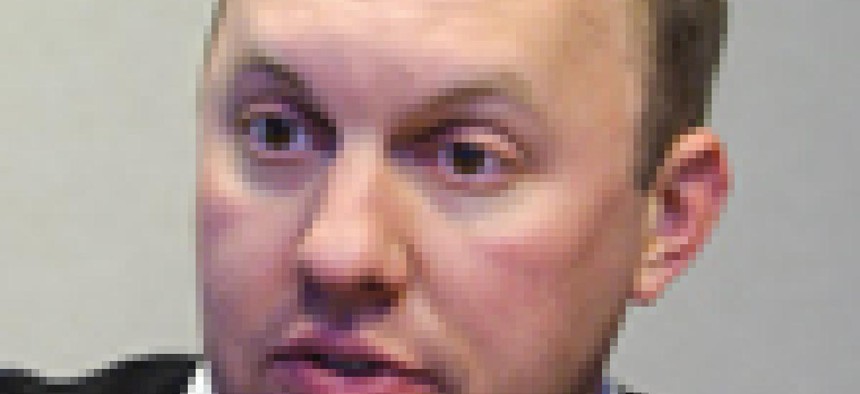Survival guide: Marc Andreessen, father of the modern Web browser

Marc Andreessen, Internet pioneer and chairman of Opsware Inc., can fit 90 minutes of insights into a 45-minute interview. He talks about as fast as technology changes.
Marc Andreessen, Internet pioneer and chairman of Opsware Inc., can fit 90 minutes of insights into a 45-minute interview. He talks about as fast as technology changes.His resume reads like a high-tech history lesson of the last decade. Having helped invent the Web browser at the University of Illinois, Andreessen moved to Silicon Valley where he co-founded Netscape Communications Corp. Netscape went public in 1995, putting it in the crosshairs of Microsoft Corp., which developed its own Web browser to rival the popular Netscape Navigator. But Netscape couldn't win, so in 1999 America Online acquired it, and Andreessen eventually moved on. He started an outsourcing company called Loudcloud Inc. that offered IT infrastructure management services. He later renamed the company Opsware and began selling Loudcloud's underlying software directly to customers.Andreessen sat down for a rapid-fire discussion with Washington Technology staff writer Brad Grimes. What do you see when you look at the technology industry today?Throughout the world, we're going through 10 or 15 years of massive growth and deployment of Web technologies. The adoption of the Web is in a 25-year, generational cycle. There was the mainframe cycle, the client-server cycle and now we're in the Web cycle.Technology has become so good. You can get so much more for your dollar now in terms of servers, software, databases and applications. It's getting easier to build applications and roll them out to large numbers of users. There's a bigger payback on technology than there has ever been. What do you see in the government IT market? A large amount of what the government is doing these days is new technology investment because, especially in military or intelligence organizations, odds are that more and better information is your primary need. Opsware started out as Loudcloud, a managed service provider. Why did you change? Yes, we were a managed service provider, and that was not something that was all that interesting, especially to defense and intelligence agencies. They didn't want to outsource. Back when we started Loudcloud in 1999, government agencies asked us if they could just license our software. For a while we said no, because we weren't a software company. We wanted to be a services company.As the economy turned, and there was a big shakeout in outsourcing, we sold our outsourcing business to EDS, switched over to being a software company and started saying yes to those agencies that wanted to buy Opsware software. What kind of contract opportunities do you see for your type of infrastructure management solution? Many of them are new systems deployments, agencies rolling out new applications. These days, if you're a defense or intelligence agency rolling out new information systems, odds are it's going to have a hundred thousand users. These aren't systems like they were in the old days. Basically, these are giant Web applications.There's also a trend in government agencies to have an internal outsourcing model. So there are internal service bureaus within [government] communities that are essentially in the business of being the equivalent of an EDS or an IBM Global Services. Have agencies shown much interest in Linux? The government is a little paradoxical on Linux. Government was always way ahead on Internet protocol adoption, but they're a little slow to take up Linux, whereas in the commercial world, Linux is just running rampant. The commercial sector has had a strong cost-cutting imperative over the last four years. That kind of imperative doesn't seem to be present in government agencies. [Agencies] could get the same benefits, they're just not under the same pressure to do so.There also were concerns early on that, because Linux was open source, it would have security issues. It turns out Linux is more secure than most proprietary systems. If I've got a design for a lock, and everyone can see those designs and still not break in, that's a solid lock. But I get a sense in the last year, as security patches and viruses have been pounding proprietary platforms, it's driving people to re-evaluate their position. How has government's use of technology evolved? Back in my Netscape days, I had one defense agency explain to me, "Look, you've got to understand our definition of security is different than yours. Security for us means if there's a router, there's a Marine with an M-16 standing by it." Clearly that's changed.----------------------Online Extra:Here are some additional observations from the co-founder of Netscape Communications, Marc Andreessen. So how's your software used today in government? Large government agencies have tens of thousands, going on hundreds of thousands of servers, and we think there's a need for a new generation of software to help automate a grid or utility-style backend to all these things. Our customers usually find that they can run their systems cheaper with our kind of software because we substitute for a lot of manual labor, but also they can roll out new applications and new services much more quickly.The [Energy Department] uses Opsware for Oracle. They've standardized their Oracle provisioning, configuration management, patch management on Opsware across their whole organization. So if you're going install Oracle inside DOE, you're doing it through Opsware. What they're doing is enforcing a DOE-blessed standardized configuration of Oracle. Then Opsware tracks all those Oracle installations so when a patch needs to be rolled out, our software coordinates that. You mentioned patch management. Is the process of administering software patches getting any better? Our customers typically have at least a hundred or more servers, usually a thousand or more servers. They usually have a group that is evaluating patches and vulnerabilities. And often they have different opinions about which patches are critical because a lot of it depends on what you're running in combination with everything else. The reason that no operating system vendor can solve this problem is that the problem is not just about patching the OS. You also have this other thing like Oracle running on top of it that may have been tested with that patch level or maybe it wasn't. So it's really a multi-vendor thing. In a dawning age of cross-agency communication and interoperability, could government agencies benefit from consolidating their infrastructure management tools? In general, yes. It would give them visibility of everything and all their assets. Another advantage would be disaster recovery. If two agencies are running something like Opsware, then they can use each other's facilities and locations for disaster recovery if they need to. Or one agency could even be an outsource provider to another agency. If it's tax season and the IRS sees a huge spike in demand, they could offload some of that demand over to DOE, for example.They could also leverage security knowledge. If there's an expert in one of the intelligence agencies that knows a lot about the criticality of patches, for example, the Department of Labor might want to take advantage of that, so people could share that information. But it's unlikely every government agency will run your software. How can agencies achieve all the advantages of consolidated infrastructure management? Since we'll never run everything, we've worked with EDS and Computer Associates and others on something called DCML, which is Data Center Markup language. It's an XML-based format for basically integrating together systems like Opsware with other systems that are running in a data center. It's a way to describe what's in your data center, what's running on your servers, how they're configured, and output that information in a common format that you can load into a completely different system.

Online extra segments of the interview that couldn't fit into the print issue are located at the end of this article.
WT:
Andreessen:
WT:
Andreessen:
WT:
Andreessen:
WT:
Andreessen:
WT:
Andreessen:
WT:
Andreessen:
WT:
Andreessen:
WT:
Andreessen:
WT:
Andreessen:
WT:
Andreessen:

Marc Andreessen
Olivier Douliery
Online extra segments of the interview that couldn't fit into the print issue are located at the end of this article.
WT:
Andreessen:
WT:
Andreessen:
WT:
Andreessen:
WT:
Andreessen:
WT:
Andreessen:
WT:
Andreessen:
WT:
Andreessen:
WT:
Andreessen:
WT:
Andreessen:
WT:
Andreessen:

